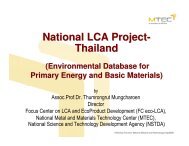ILCD Handbook: Framework and requirements for LCIA models and ...
ILCD Handbook: Framework and requirements for LCIA models and ...
ILCD Handbook: Framework and requirements for LCIA models and ...
You also want an ePaper? Increase the reach of your titles
YUMPU automatically turns print PDFs into web optimized ePapers that Google loves.
<strong>ILCD</strong> <strong>H<strong>and</strong>book</strong>: <strong>Framework</strong> <strong>and</strong> <strong>requirements</strong> <strong>for</strong> <strong>LCIA</strong> <strong>models</strong> <strong>and</strong> indicators First edition<br />
Toxicity<br />
Bioaccumulation/magnification<br />
Effects on biodiversity<br />
Table 4-7 presents the general <strong>and</strong> specific criteria <strong>for</strong> eco-toxicity, identifying the<br />
minimum score to be met (threshold value) <strong>and</strong> the most relevant criteria <strong>for</strong> the impact<br />
category (importance).<br />
Table 4-7 General <strong>and</strong> specific criteria <strong>for</strong> eco-toxicity with threshold value <strong>and</strong> importance.<br />
ECOTOXICITY Check the following:<br />
Introduction<br />
Completeness of<br />
scope<br />
Environmental<br />
relevance<br />
Overall evaluation<br />
• Timeframe, discounting, etc.<br />
• Marginal (M) or Average (A) defined, if not described<br />
(ND)<br />
Total number of substances covered by the provided<br />
characterisation factors<br />
• The impact indicator covers the majority of impact<br />
mechanisms <strong>and</strong> relevant elementary flows <strong>for</strong> the AoP<br />
Human Health<br />
• The impact indicator covers the majority of impact<br />
mechanisms <strong>and</strong> relevant elementary flows <strong>for</strong> the AoP<br />
Natural Environment?<br />
• The impact indicator covers the majority of impact<br />
mechanisms <strong>and</strong> relevant elementary flows <strong>for</strong> the AoP<br />
Natural Resources<br />
• The midpoint indicator is chosen in a way that all LCI<br />
are appropriately aggregated as early as possible in the<br />
cause effect chain<br />
• The characterisation model is adaptable to spatial <strong>and</strong><br />
temporal explicit evaluation<br />
• Global geographical validity preferable, separate<br />
validity <strong>for</strong> Europe beneficial<br />
• The method is compatible with, or developed<br />
specifically <strong>for</strong>, the comparative assessment scope of<br />
LCA (e.g. factors do not include security factors /<br />
precautionary principle)<br />
• When empirical data is used, double counting is<br />
avoided<br />
The following critical parts of the environmental<br />
mechanism describing the cause-effect chain are<br />
included with acceptable quality:<br />
• Advection out of a region or of a continent is not<br />
considered a final loss.<br />
• Marine environment <strong>and</strong> coastal zone are differentiated<br />
• Influential fate processes are considered (classic -<br />
volatilization, deposition/sedimentation, intermittent rain)<br />
• The effect factors are derived from the average toxicity<br />
over all species instead of the most sensitive species<br />
• Direct effects on species diversity of toxicants are<br />
considered<br />
Threshold<br />
(Minimum<br />
score)<br />
B H<br />
B H<br />
C H<br />
C H<br />
C H<br />
Importance<br />
(H-N)<br />
4 Requirements <strong>for</strong> specific impact categories 70



